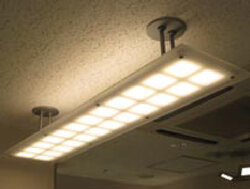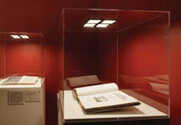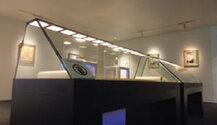Lately, the term “organic” has become very popular in a food industry. Besides many benefits for our health, the organic molecules have specific characteristics, which can be very useful while implemented into LED products. New type of LED lighting is had been developed in order to provide a broad illumination and extraordinary colour rendering. This new system became widely available in late 2011, firstly in Japan, then North America. The main advantage of organic LEDs – OLEDs – over the traditional LEDs is the OLEDs provide soft, diffuse lighting, which does not throw shadows. OLEDs are not a point light source but ideal for evenly illuminating object and spaces.

How does it work?
Light emission by organic compounds was first observed in early 1950s and incorporated into a light emitting diode in the mid-1980s. Since then, the technology has been implemented into many different display devices, such as OLED televisions, smartphones, PDA screens.
A light emitting substance in the OLEDs is an organic semiconductor. A cathode is attached to the back of the semiconductor and an anode to the front. An electric current then excites the electrons in the semiconductor into higher energy states. As the electrons return to their ground state, this excess energy is converted to light. The light is projected through the anode and a glass (or plastic) substrate, creating a surface light source that is remarkably thin, highly efficient, and not a significant source of heat.
The main disadvantages of OLEDs are sensitivity to water and highly reflective surface. These facts exclude the OLEDs from the outdoor use, but do not really matter if installed indoors.
OLED in Lighting Systems
An OLED module is formed by two compounds – an OLED panel and a base unit. The organic light emitting diode forms part of the OLED panel enclosed in a plastic case in order to protect it from a mechanical damage. The panel is fixed to the base unit. Holding the OLED panel in the right place is the first function of the base unit. Secondly, there is a voltage/current regulator to power the panel involved in the base unit. The number of modules per power supply depends on the wattage.
OLED module is less than 10 mm in height and provides a diffuse white light. Few modules together can create a wall of light without generating significant heat. Common OLED panel operation time is about 10.000 hours. Once having passed this period, flickering can occur. In such a case, flickering OLED panel can be replaced within the module. In order to make this process easier, check the product´s minimum spacing requirements before the OLED wall installation. Despite the fact the panel shuts down automatically if removed while power is on, it is convenient to disconnect the power from the base unit before the OLED panel is changed within the module.
General information on the OLED modules installation
When it comes to aesthetics and design, OLED modules provide very few limitations. The most important technical limitations are temperature and heat dissipation—both of which can have a significant effect on panel life, light output, and electrical interface. Due to its sensitivity to water, OLED modules are generally meant for dry indoor environment with an ambient temperature near the fixture in the general range of 5° to 35°C.There will also be limits for the temperature at dead centre on the bottom of the base unit and dead centre of the exposed surface of the OLED panel. Relative humidity should remain below 85 per cent. Higher temperatures and/or humidity will accelerate lumen depreciation and may cause premature device failure. Individual product´s characteristics may vary so it’s always wise to check the specifications.
In most product designs, the base unit enables the OLED module to work with 0-10V Class 2 control devices, and some products even allow other control technologies use. An OLED module can commonly be dimmed from full brightness to as low as three per cent. In addition, OLED light level can often be customized during the installation so that the fixture isn’t drawing more power than is needed (i.e., over-lighting) for the application. Despite being installed in great numbers, OLED modules do not produce significant heat so that fixtures can be situated touchably close to the end users. They can even be incorporated into walls, furniture or used in clothing.
Advantages & Disadvantages
OLED fixtures share basic advantages with traditional LED fixtures – low energy consumption and extended lifespan. For example, a mix of LED and OLED fixtures was installed in Jiyugaoka Rail Station in Tokyo in March 2012. The installation helped to reduce the power consumption of the system by 40 per cent.
OLED panels provide diffuse illumination without the need for reflectors in the fixture. Moreover, OLED fixtures provide a very high level of colour rendering. With colour consistency commonly rated at <3.5 SDCM and a Colour Rendering Index (CRI) of >90, OLED fixtures can meet the needs of the most demanding applications, such as museums and galleries. OLED modules produce minimal UV and IR rays, a frequent cause of colour fade and other light-sensitive material damages. For both colour rendering and protection of priceless artwork, the National Museum of Modern Art in Kyoto, Japan got a prototype OLED system installed by mid-2011 in time for a weaving exhibit that featured resplendent colours and materials.


The primary disadvantage of OLED lighting is a price. But if the positive properties of OLED technology, such as the thin panel, comfort at close range, or superior colour rendering, are required to meet the specific needs of the application, the energy saving achieved by OLEDs becomes cost effective.
Future
Since the OLEDs became popular firstly in Japan and then in North America, we simply have to look back to Japan to see their future in North America. Due to their need for colour consistency and non-harmful lighting, museums would be the first customers in there, too. In addition, OLED fixtures will be installed within projects involving LED lighting systems, when close lighting is required. In the future, new niche designs will be developed in order to take the advantage of the OLED modules´ flexibility, to make the best use of space in a wide variety of applications, offices and retail facilities.
The OLED fixtures offer engineers and lighting professionals an opportunity to tune their designs for specific applications, meeting exactly the needs of any kind of installation while reducing the energy waste. With a “right tool for the right job” mentality, OLED fixtures are ideal for improving functionality and energy efficiency within a larger lighting design.
SOURCE:
- Brosius, B.: LEDs Go Organic The Science behind OLED Lighting Systems, pubished in Lighting Technology, September/October 2013
